The Umbilical Market is estimated to be valued at USD 4.5 million in 2025 and is projected to reach USD 41.9 million by 2035, registering a compound annual growth rate (CAGR) of 25.0% over the forecast period.
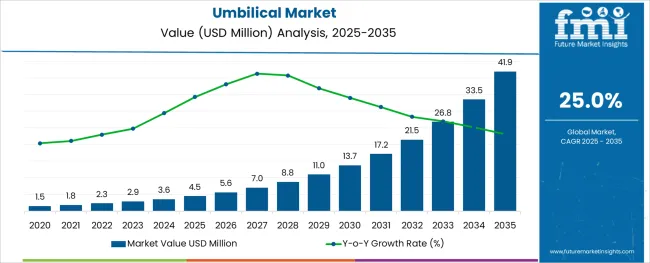
The alginic acid market is undergoing consistent growth, propelled by rising demand from food processing, pharmaceutical formulations, and cosmetic applications. A growing focus on natural and sustainable ingredients in manufacturing processes has positioned alginic acid as a preferred biopolymer across industries.
The market is further supported by its diverse functional benefits, including water retention, gelling, and stabilizing properties, which make it indispensable in high-performance formulations. Increased regulatory acceptance of alginates as safe additives and the push towards cleaner labeling in food and personal care products have reinforced their adoption.
Ongoing innovation in extraction technologies and the utilization of algae as a renewable resource are paving the way for cost-effective production and expanded applications, ensuring sustained market expansion in the coming years.
The market is segmented by Depth and region. By Depth, the market is divided into Shallow, Deep, and Ultra-Deep. Regionally, the market is classified into North America, Latin America, Western Europe, Eastern Europe, Balkan & Baltic Countries, Russia & Belarus, Central Asia, East Asia, South Asia & Pacific, and the Middle East & Africa.
When segmented by salts, sodium alginate is expected to command 27.5% of the market revenue in 2025, marking it as the leading subsegment in this category. This leadership has been driven by its superior solubility, ease of incorporation into formulations, and versatility in a wide range of applications.
Its ability to form stable gels and maintain viscosity under varying conditions has made it highly sought after in both food and pharmaceutical sectors. Manufacturers have prioritized sodium alginate due to its consistent performance, cost-effectiveness, and regulatory acceptance, which have collectively strengthened its position.
The segment’s prominence has also been enhanced by its adaptability to evolving consumer preferences for plant-derived and sustainable ingredients, reinforcing its market share.
However, the pandemic disrupted the global supply chain, creating an energy crisis across the world that resulted in increased prices. Stringent lockdowns caused nationwide shutdowns of subsea production facilities, impacting production volumes, which may have created roadblocks for the industry.
Furthermore, as the disruptions from the pandemic continue to recede and oil & gas activities improve, the industry could be headed toward gradual recovery in the forthcoming years. The global demand for Umbilical is projected to increase at a CAGR of 25% during the forecast period between 2025 and 2035, reaching a total of USD 41.9 Billion in 2035, according to a report from Future Market Insights (FMI). From 2020 to 2024, sales witnessed significant growth, registering a CAGR of 20%.
Exploration of New Offshore Reserves with Substantial Output Capacities pushing Growth of the Market
The discovery of new reserves coupled with the abundance of unexplored hydrocarbon resources across ultra-deep, deep, and shallow offshore locations has resulted in new exploration & production (E&P) activities, thus proliferating the demand for the umbilical market.
For instance, in April 2025, oil & gas major ExxonMobil announced the launch of three new offshore reserves in Guyana with an overall recoverable volume equivalent to 11 billion oil barrels.
Furthermore, new oil and gas exploration projects have been launched to meet the world's rising demand for oil and gas. As a result, there is now a greater need for monitoring oil and gas facilities and leak detection systems. A cutting-edge processing facility for natural gas has been built on various new properties.
It is anticipated that such oil and gas exploration and production operations will increase the demand for umbilicals in the upcoming years.
Decreasing Prices of Crude Oil Hindering Growth
There has been a drop in crude oil prices at a global level. 2024 saw an 3.6 billion barrel decline in proven crude oil reserves and a 560 million barrel decline in proven lease condensate reserves. The proved reserves of USA crude oil and lease condensate decreased by 19 percent, from 47.2 billion barrels to 38.2 billion barrels at the end of 2024, according to the USA impact assessment study from January 2025. The shrinking crude oil reserves are hampering the total market expansion.
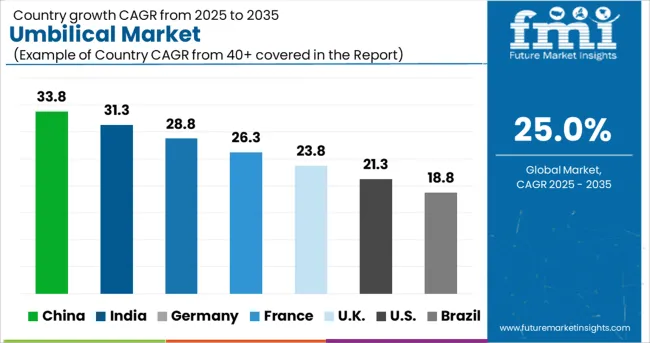
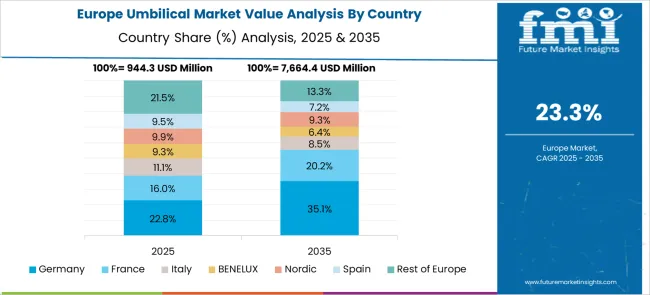
Increasing Investments are Spurring Demand for Umbilical
The Europe umbilical market size is anticipated to register commendable growth from 2025 to 2035, due to a rise in offshore activities in the North Sea. Surging explorations of new reserves in addition to supportive administrative regulations by different national governments will further stimulate regional industry growth.
For instance, in January 2025, Norway’s Ministry of Petroleum and Energy announced the extension of its APA 2024 (Award in Pre-Defined Areas 2024) program to improve the discovery activities across the national continental shelf and exhibit 53 new production licenses to 28 companies.
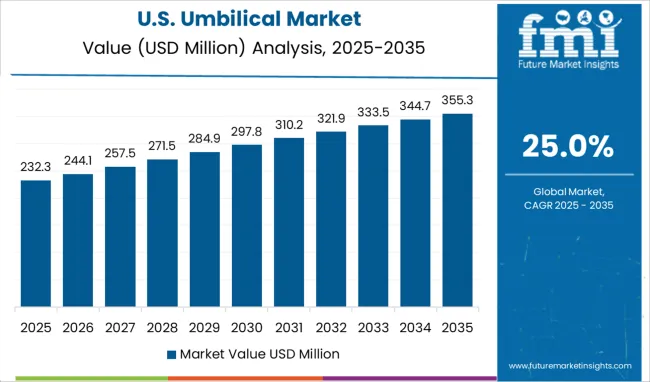
Increased Exploration Initiatives to Drive the Adoption of Umbilical
The growth in the region is owed to increased investments in fresh crude oil discoveries and a promising outlook for developing unconventional sources. In addition to this, the business environment will improve by emphasizing digitization and automation of drilling operations, and crude oil production rates will rise. An Increasing number of firms are investing more money in exploration and production initiatives.
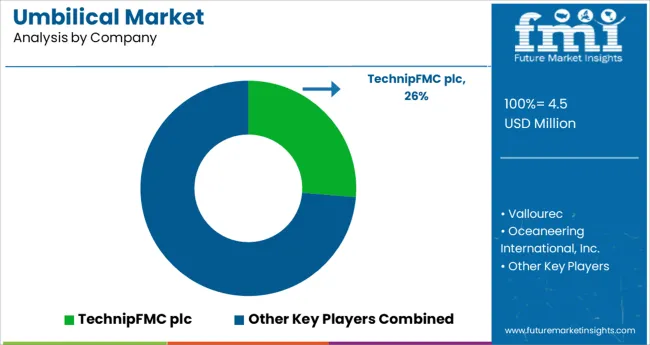
Key players in the Umbilical market are TechnipFMC plc, Vallourec, Oceaneering International, Inc., Aker Solutions, John Wood Group, Plc, Saipem, McDermott, Schlumberger Limited, NOV, Inc., Prysmian Group, Subsea 7, HALLIBURTON, Baker Hughes Company, and Nexans.
| Report Attribute | Details |
|---|---|
| Market Value in 2025 | USD 4.5 million |
| Market Value in 2035 | USD 41.9 million |
| Growth Rate | CAGR of 25% from 2025 to 2035 |
| Base Year for Estimation | 2024 |
| Historical Data | 2020 to 2024 |
| Forecast Period | 2025 to 2035 |
| Quantitative Units | Revenue in billion and CAGR from 2025 to 2035 |
| Report Coverage | Revenue Forecast, Volume Forecast, Company Ranking, Competitive Landscape, Growth Factors, Trends, and Pricing Analysis |
| Segments Covered |
Depth, Region |
| Regions Covered | North America; Latin America; Europe; Asia Pacific; Middle East & Africa |
| Key Countries Profiled | USA, Canada, Brazil, Mexico, Germany, United Kingdom, France, Spain, Italy, Russia, China, Japan, India, South Korea, Australia, South Africa, Saudi Arabia, United Arab Emirates(UAE), Israel |
| Key Companies Profiled | TechnipFMC Plc.; Vallourec; Oceaneering International, Inc.; Aker Solutions; John Wood Group Plc.; Saipem; McDermott; Schlumberger Limited; NOV, Inc.; Prysmian Group; HALLIBURTON |
| Customization | Available Upon Request |
The global umbilical market is estimated to be valued at USD 4.5 million in 2025.
It is projected to reach USD 41.9 million by 2035.
The market is expected to grow at a 25.0% CAGR between 2025 and 2035.
The key product types are shallow, deep and ultra-deep.
segment is expected to dominate with a 0.0% industry share in 2025.






Full Research Suite comprises of:
Market outlook & trends analysis
Interviews & case studies
Strategic recommendations
Vendor profiles & capabilities analysis
5-year forecasts
8 regions and 60+ country-level data splits
Market segment data splits
12 months of continuous data updates
DELIVERED AS:
PDF EXCEL ONLINE
Umbilical Tapes Market
Umbilical Vessel Catheters Market
Subsea Umbilical Clamps Market Analysis - Size, Share, and Forecast Outlook 2025 to 2035
Subsea Umbilicals Risers And Flowlines Market Size and Share Forecast Outlook 2025 to 2035
Disposable Umbilical Cord Protection Bag Market Size and Share Forecast Outlook 2025 to 2035
Deep Depth Subsea Umbilicals, Risers and Flowlines Market Size and Share Forecast Outlook 2025 to 2035

Thank you!
You will receive an email from our Business Development Manager. Please be sure to check your SPAM/JUNK folder too.
Chat With
MaRIA